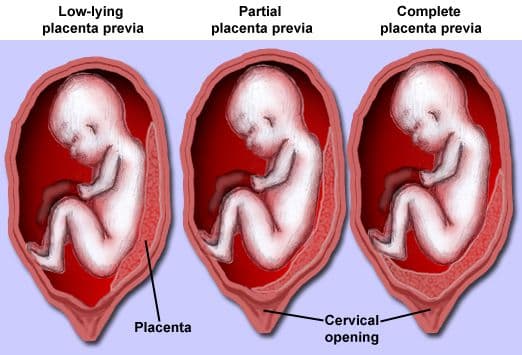What Is Placenta Previa?
Complications
Obie Editorial Team

- Smoking
- Cocaine use
- Maternal age: Under 20 or over 35
- Multiple previous pregnancies
- History of uterine surgery (e.g., C-section, D&C, fibroid removal)
- Previous placenta previa (raises risk by 2-3 percent)
- Complete placenta previa: The placenta completely covers the cervix.
- Partial placenta previa: The placenta partially covers the cervix.
- Marginal placenta previa: The placenta is adjacent to the cervix.
- Low-lying placenta previa: The placenta is near the cervix, within two centimeters, but not directly next to it.
- Empower yourself with knowledge about placenta previa.
- Prepare mentally and physically for a possible C-section birth.
- Focus on self-care during bed rest—use this time to bond with friends or prepare for your baby's arrival in practical ways.
- Placenta: How It Works, What’s Normal. Mayo Clinic. Accessed January 27, 2015.
- Placenta Previa. Mayo Clinic. Accessed January 27, 2015.
- Placenta Previa. March of Dimes. Accessed January 28, 2015.
- Placenta Accreta and Percreta: Incidence, Risks, Diagnosis, Counseling and Preparation for Delivery. California Maternal Quality Care Collaborative. Accessed January 28, 2015
The placenta is an essential organ that forms in your womb during pregnancy. Think of it as your baby's lifeline—it is through the placenta that your baby receives nutrients and oxygen while ridding its body of waste products. It attaches to the inner wall of your uterus and is connected to your baby via the umbilical cord. Typically, the placenta attaches at the top or side of the uterus; however, in cases of placenta previa, it attaches near or directly over the cervix, the opening to the uterus that plays crucial roles in menstruation, conception, and childbirth.
What is placenta previa and how common is it?
Placenta previa occurs when the placenta develops near or covers the cervix. This condition occurs in about 1 in 200 pregnancies. The exact causes are not fully understood, but certain factors can elevate your risk, including smoking, cocaine use, being under 20 or over 35, having multiple previous pregnancies, a history of uterine surgery like C-sections, and a prior diagnosis of placenta previa.
Are there different types of placenta previa?
Yes, there are four main types of placenta previa, which are determined by how much of the cervix is covered:
Symptoms, diagnosis and complications
Placenta previa is often identified during a second-trimester ultrasound. Symptoms can range from light to heavy, painless vaginal bleeding characterized as bright red, usually occurring in the later stages of pregnancy. Contractions may or may not accompany this condition. If you experience these symptoms, contact your healthcare provider immediately, or seek urgent medical care if the bleeding is severe. While most instances resolve before birth, complications can include significant maternal bleeding (hemorrhage) and pre-term birth, so ongoing communication with your doctor is crucial.
Is there treatment available?
Treatment for placenta previa depends on individual circumstances and symptoms. Most often, a C-section will be recommended over vaginal delivery. Management can range from close monitoring (often in a hospital setting) to having blood transfusions if bleeding is considerable. In severe cases, corticosteroids could be administered to help your baby's organs to develop faster in anticipation of an early delivery. Your healthcare provider may recommend a C-section if bleeding becomes severe, especially around 34-36 weeks of pregnancy, or if tests show your baby's lungs are mature by 36-37 weeks through amniocentesis. The ultimate goal is to extend the pregnancy safely, but if health risks are considerable, an early C-section may be necessary.
Are there certain things I need to avoid?
Your situation will guide what activities you may need to limit. If your bleeding is light or absent, you may be placed on home bed rest, with specifics tailored to your condition. Engaging in sexual intercourse and physical exercise might be contraindicated. If heavy bleeding occurs, hospital admission with bed rest and observation by healthcare providers is crucial. In these cases, blood transfusions and medicines to prevent preterm labor might be needed, with the possibility of an immediate C-section in life-threatening conditions.
How to cope with a diagnosis of placenta previa
Facing a placenta previa diagnosis can be overwhelming, but there are effective ways to manage it:
Sources:







